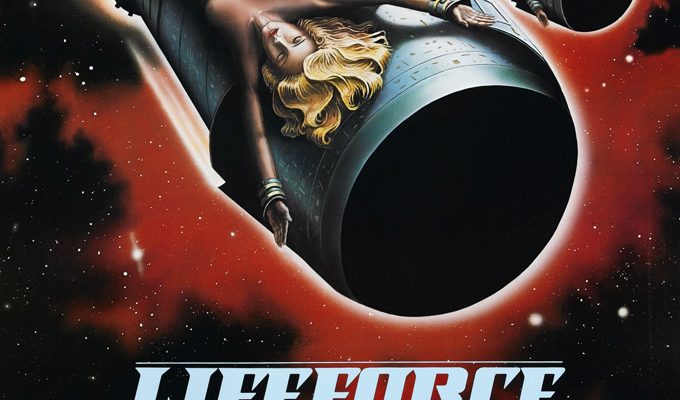 4. Post-Production Was A Nightmare
4. Post-Production Was A Nightmare
For some reason the post-production woes of “Lifeforce” were shied away from on the new disc, but there could have probably been an entire Blu-ray filled with behind-the-scenes stories of how tough “Lifeforce” was to get done. Supposedly it began during production, with the shoot falling behind schedule and over-budget. (Cannon wasn’t exactly regulated in the same way the big studios were.) According to one of the actors, this caused major scenes in the script to never be shot and at least partially explains the weirdly disjointed nature of “Lifeforce,” which oddly doesn’t affect the movie negatively but instead adds to its gauzy, dreamlike atmosphere. Production also frequently suffered from technical setbacks afford by its complex effects. “My mechanical effects were not easy to deal with at the time because sometimes they would work and sometimes a cable would break,” Hooper said. From his vantage point the scenes with the effects were often even sillier than what ended up on screen because he could see the 20 or so technicians required operating each puppet. In post-production, though, the film nearly fell apart. While painstaking effects work continued under the supervision of John Dykstra, the wizard who worked on “Star Wars” and “Close Encounters of the Third Kind,” almost everything else broke down. Hooper delivered his initial cut, which ran 128 minutes and again catered to the “epic” sensibilities of the movie. But both Cannon and domestic distributor TriStar were unhappy with the running time and almost a full half hour was trimmed, much to Hooper’s dismay. (Most of the footage came from the Churchill spacecraft stuff at the beginning.) Other bizarre alterations to the final domestic cut (most of which have been reinstated but not at the original 128-minute running time) included cues from the unforgettably spacey score by Henry Mancini being replaced by similar music by “Die Hard” composer Michael Kamen and, in an effort to make the movie “less British,” a handful of the English actors’ voices were replaced by American dubs. Still, a lengthier version has been reinstated but Hooper’s initial 128-minute cut has yet to resurface from the cold recesses of space.
 5. It Was The Last Big Movie Tobe Hooper Would Ever Get To Make
5. It Was The Last Big Movie Tobe Hooper Would Ever Get To Make
Maybe the most tragic thing about “Lifeforce” isn’t its initial critical and commercial dismissal but the fact that Hooper would never make a movie of its size and scope again. On the special features on the new disc he still sounds giddy about the opportunities “Lifeforce” afforded him: “It can’t get better than this, especially when I burned those streets out. It was awesome to go out to a street that looked absolutely real to me and fire would blow out the windows,” Hooper said. “It was great times.” After his initial smash “The Texas Chainsaw Massacre,” Hooper would go on to make a handful of really wonderful horror movies like “Eaten Alive,” “The Funhouse” (one of the most visually jaw-dropping horror movies ever) and the Steven Spielberg-produced “Poltergeist,” although whether or not Spielberg directed a majority of the movie remains a sorely contentious subject of film nerd debate. But after Hooper’s Cannon-backed three-movie streak, which included a riotous horror-comedy remake/sequel/spoof of ‘Texas Chainsaw Massacre,’ Hooper never returned to his former glory. He was never allowed the kind of money that “Lifeforce” gave him, so both the scale and ambition of the movies that followed, shrank dramatically. Even though he had started out making micro-budgeted chillers, his mojo was spent and creatively his post-Cannon movies, things like 1990’s “Spontaneous Combustion” felt antsy and unfocused. By the 2000s he was down to making direct-to-video schlock and filming uneven episodes of the cable anthology series “Masters of Horror.” Even with his depleted mojo, he still remains a Master of Horror, and we hope against hope he’ll be given the opportunity and budget to stage a comeback. Though, it seems about as likely as a spaceship discovering a sideways castle full of vampires.
There are a number of interesting doodles from “Lifeforce” that are explored on this great new Blu-ray, including how Patrick Stewart’s first on-screen kiss was with Steve Railsback, and the circumstances that allowed for Dan O’Bannon to write the screenplay for “Lifeforce” (it goes back to unsung classic “Return of the Living Dead,” which O’Bannon and Hooper were supposed to collaborate on). But what this new edition of “Lifeforce” really does is give you the opportunity to enjoy and appreciate Hooper’s “70 mm Hammer film” in all of its glory. It’s a true horror epic, the kind they just don’t seem to make anymore (and, no, “World War Z” doesn’t count).

